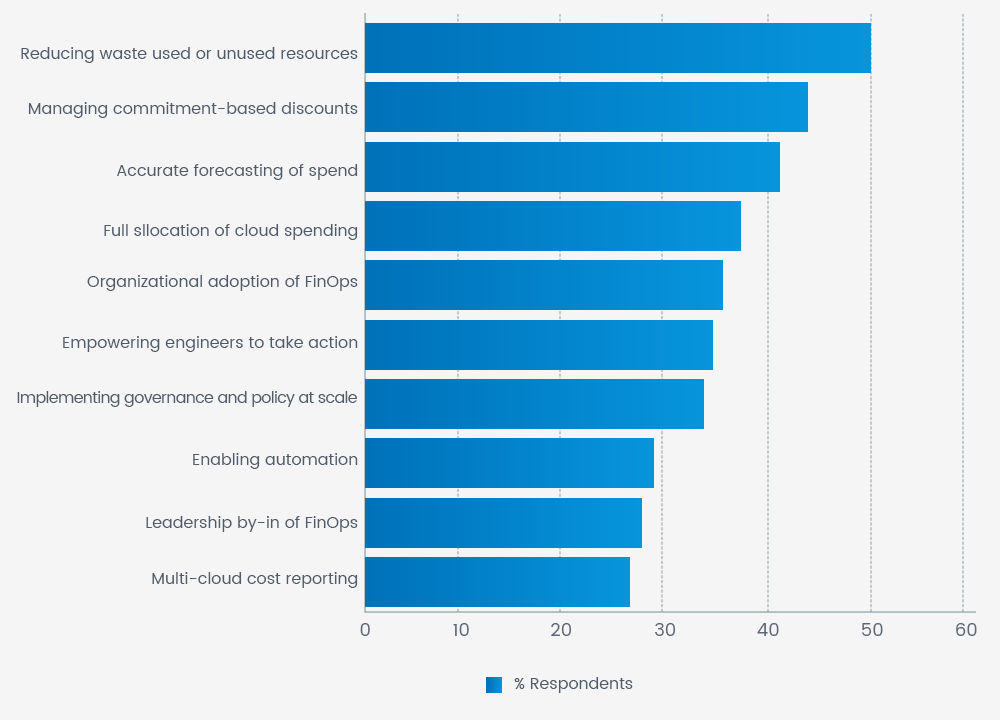
Cloud gives data scientists easier access to data and facilitates experimentation with the latest AI technologies. To support the rapid rise of AI, more organizations are migrating their data and applications to Cloud. Rapidly increasing cloud costs has spurred the need for a systematic methodology to manage cloud costs.
Financial Operations, or FinOps, is a framework for managing cloud costs and optimizing cloud spending. The goal of FinOps is to control the cost of cloud adoption without hampering developer creativity and freedom. FinOps isn’t just about reducing costs but maximizing the value of all cloud expenditures.
The 2024 State of FinOps finds that reducing waste is the highest priority for FinOps practitioners indicating that businesses are looking at ways to reduce spending without reducing the value they are getting from cloud investments.

In another survey carried out by Everest Group, 82% of global organizations struggle with more than 10% of their cloud spending getting wasted. Out of these, 68% experience more than 20% wastage.
The FinOps Imperative
FinOps empowers organizations to extract business value from the Cloud, wherein cost optimization is a core value proposition. By ensuring different stakeholders have ownership and accountability of the Cloud spend, FinOps ushers in a cultural change by facilitating close collaboration between different teams to achieve conflicting business objectives such as speed, cost, and quality of IT infrastructure.
By implementing FinOps best practices, organizations can effectively manage cost, and resource utilization and maximize ROI. Based on our experience with customers, here are some of the best practices for managing and reducing wasteful expenditure.
Reducing Cloud Waste
1. Compute
Right Sizing: It is important to select the right Cloud resources and align it with business objectives to achieve the desired level of performance cost-effectively. For instance, compute instances are available with various combinations of CPU speed, CPU count, memory, networking, storage I/O, and GPUs. Right instance selection will require analysis of current workload, and future growth as well as analysis of resource utilization data available from Cloud observability tools.
Use Autoscaling and Load Balancers: Cloud empowers users with automated scaling capabilities, so users can programmatically configure auto-scale to add resources when there is heavy traffic and scale down when the traffic reduces. You can also use load balancers to manage sudden spikes in traffic to distribute calls and optimize performance. Resources can be optimized by observing auto-scaling. For example, if there is frequent scaling up due to high memory usage while CPU usage is very low, it will be more sensible to select a memory-optimized compute resource.
Turn off idle resources: Unlike traditional environments, the ability to shut down resources is one of the major benefits of Cloud. However, as organizations experience a Cloud sprawl with multiple accounts, they often end up paying for idle servers that are left on after a project is over. Tools enable to manage multiple Cloud usage via a central dashboard such as AWS Organization and Google Cloud’s Organization Resources.
Move to Serverless: Based on workload and utilization, one can reduce waste by moving to serverless architecture. Serverless does not require to rent servers and savings are a result of the pay-for-use model and reduced dependence on operations staff. Serverless is suited for non-production environment where latency is not very crucial and automatic pause can be configured to save costs.
2. Storage
Right Sizing: Selecting the right storage option is imperative to extract the best value. For instance, the selection of hard drives or SSDs must be aligned with performance, latency, and throughput requirements. Different storage tiers such as hot, cool, cold, and archive must be selected based on data size and access pattern. Migration to newer SKUs may also result in saving –for example, EBS volume migration from gp2 to gp3.
Storage Lifecycle: Database backups, snapshots of storage, and logs require large storage capacity and form a significant proportion to cloud cost. Based on business requirements, data must be automatically moved from expensive tiers to cheaper ones and deleted when the retention period is complete.
3. Unattached/Abandoned Resources
Often when host VMs are removed, resources like network interface cards, managed disks, EBS volumes get unattached but are not deleted. It is important to monitor, switch off/delete these resources to reduce wastage. Robust enforcement of resource provisioning using Infrastructure-as-code can prevent such occurrences while periodic checking for infrastructure anomalies can help detect abandoned resources.
4. Idle Resources
Apart from compute and storage, one must monitor other idle or under-utilized resources such as load balancers, containers, app services, and empty databases.
5. Data Transfer
Ingress and egress charges are costs associated with data transfer across cloud regions, across zones, to and from the internet, and to and from on-premises networks. Generally, Cloud vendors do not charge for ingress, but charge for data egress. The cost of data egress often comes as a shock but designing a thoughtful architecture can significantly cut down data transfer cost by limiting the movement of data out of the region or from the Cloud environment. For example, if some of your on-premises applications are frequently accessing cloud data, it may be time to migrate these applications.
Partner with FinOps Experts for Cost Management
FinOps require unique skills and expertise—it entails deep understanding of different Cloud environment and services, market understanding, expertise in monitoring and management tools and deep experience to identify waste and optimize performance. Working with the right partner brings the insights, experiences and best practices garnered from different customers to reduce the learning curve and maximize the benefits of Cloud quickly and easily.
If you want to know more about NewVision’s FinOps practice or want help with Cloud cost optimization strategies, write to us at contact@newvision-software.com.


